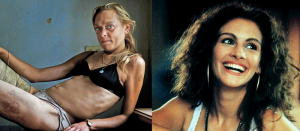A blog post on exoduscry.com that was published on March 25th – the 25 anniversary of the launch of Pretty Woman – and then was reposted by the Australian site Mamamia, described how young women can be lured into a life of prostitution because owing to the glorified image conveyed in Pretty Woman.
The post discussed what impact a single movie may have had, but that it is impossible to confirm how many young girls that have been lured into a life of prostitution because of the image that is conveyed. But the fact is that the photo of Julia Roberts as the “happy hooker” is the image that the media, the film industry and magazines tend to spread when prostitution is observed.
However, the reality is in fact the opposite. It is symbolized by the image of Maria below and reinforced by the statistics that follow:
75 % of the women in prostitution have been raped
95% of the women in prostitution have been victims of some form of physical violence or abuse
68 % of women in prostitutions suffer from post-traumatic stress (1)

As a reaction of the blog post Tilly Lawless posted, who lives in prostitution, a photo at Instagram under the hashtag #facesofprostitution to put a stop to the, according to her erroneous, image of prostitutes as human trafficking victims who need rescue. Her post circulated all over the world with articles published in, among others, Vice, BBC, the Mirror and Daily Life.
The post on exoduscry.com that aimed at highlighting the reality of many women who are forced into prostitution by traffickers barely got any mass medial circulation. But when the campaign #facesofprostitution was created by Tilly, it spread quickly.
That I even choose to illustrate this at the blog is to highlight how “normal” media and social media quickly choose side and decide to elucidate freedom of choice, that women by themselves choose a life in prostitution and that they are happy. The image that is conveyed in the movie Pretty Woman brings up to date and is being embraced by the media.
But out of all the young girls and women that, by human traffickers, are forced into a life of sexual slavery – how many of these have internet access and the possibility to be active on social media?
Most likely none. That the debate is allowed to be dominated by a minority of seemingly “lucky prostitutes” who want to convey the message of volunteerism, entrepreneurship and control over one’s own body is problematic. In particular when media generalize the group and see these individuals as representatives of a large group of people who in fact is vulnerable, marginalized, oppressed and forced into a life of sexual slavery.
People who are forced into prostitution and sex slavery do not drive campaigns about legalizing sex trade. Those people who emphasize the difference between “voluntary” prostitutes and those who are trafficked do so in order to normalize prostitution. No prostitutes are volunteers and everyone are victims of the consequences of commercialized sexual abuse (see previous blog post about Rachel Moran’s book Paid For).
Commercialized and legalized sex trade, driving demand, forcing more young women and girls into sex slavery and it is those who are marginalized and forgotten by campaigns #facesofprostitution.
The campaign #facesofprostitution is spread like wildfire on Twitter. But the question we must ask ourselves is whether it really shows #theREALfacesofprostitution?
[1] Farley, Melissa et al. “Prostitution and Trafficking in Nine Countries: An Update on Violence and Posttraumatic Stress Disorder.” Journal of Trauma Practice, Vol. 2, No. 3/4: 33-74. 2003.; and Farley, Melissa. ed. Prostitution, Trafficking, and Traumatic Stress. Haworth Press, New York. 2003.


